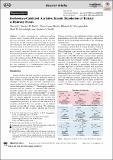Files in this item
Isothiourea-catalyzed acylative kinetic resolution of tertiary α-hydroxy esters
Item metadata
| dc.contributor.author | Qu, Shen | |
| dc.contributor.author | Smith, Samuel | |
| dc.contributor.author | Laina-Martin, Victor | |
| dc.contributor.author | Neyyappadath, Rifahath | |
| dc.contributor.author | Greenhalgh, Mark David | |
| dc.contributor.author | Smith, Andrew David | |
| dc.date.accessioned | 2020-07-16T13:30:03Z | |
| dc.date.available | 2020-07-16T13:30:03Z | |
| dc.date.issued | 2020-09-14 | |
| dc.identifier | 268315040 | |
| dc.identifier | 1465fd1e-4ba1-4e77-9e1b-26b6fae44474 | |
| dc.identifier | 000548652500001 | |
| dc.identifier | 85090303416 | |
| dc.identifier.citation | Qu , S , Smith , S , Laina-Martin , V , Neyyappadath , R , Greenhalgh , M D & Smith , A D 2020 , ' Isothiourea-catalyzed acylative kinetic resolution of tertiary α-hydroxy esters ' , Angewandte Chemie International Edition , vol. 59 , no. 38 , pp. 16572-16578 . https://doi.org/10.1002/anie.202004354 | en |
| dc.identifier.issn | 1433-7851 | |
| dc.identifier.other | ORCID: /0000-0002-2104-7313/work/77524516 | |
| dc.identifier.uri | https://hdl.handle.net/10023/20270 | |
| dc.description | Funding: ERC under the European Union's Seventh Framework Programme (FP7/2007–2013)/E.R.C. grant agreement no. 279850. The Chinese Scholarship Scheme and University of St Andrews are thanked for a CSC Scholarship (S.Q.). Universidad Autónoma de Madrid is thanked for a predoctoral fellowship (V.L.-M.). We thank the EPSRC Centre for Doctoral Training in Critical Resource Catalysis (CRITICAT, grant code EP/L016419/1) for funding (R.M.N.). A.D.S. thanks the Royal Society for a Wolfson Research Merit Award. | en |
| dc.description.abstract | A highly enantioselective isothiourea-catalyzed acylative kinetic resolution (KR) of acyclic tertiary alcohols has been developed. Selectivity factors of up to 200 were achieved for the KR of tertiary alcohols bearing an adjacent ester substituent, with both reaction conversion and enantioselectivity found to be sensitive to the steric and electronic environment at the stereogenic tertiary carbinol centre. For more sterically-congested alcohols, the use of a recently-developed isoselenourea catalyst was optimal, with equivalent enantioselectivity but higher conversion achieved in comparison to the isothiourea HyperBTM. Diastereomeric acylation transition state models are proposed to rationalize the origins of enantiodiscrimination in this process. This KR procedure has also been translated to a continuous flow process using a polymer-supported variant of the catalyst. | |
| dc.format.extent | 8 | |
| dc.format.extent | 2362944 | |
| dc.language.iso | eng | |
| dc.relation.ispartof | Angewandte Chemie International Edition | en |
| dc.subject | Kinetic resolution | en |
| dc.subject | Enantioselectivity | en |
| dc.subject | Acyl transfer | en |
| dc.subject | Organocatalysis | en |
| dc.subject | Tertiary alcohol | en |
| dc.subject | QD Chemistry | en |
| dc.subject | DAS | en |
| dc.subject.lcc | QD | en |
| dc.title | Isothiourea-catalyzed acylative kinetic resolution of tertiary α-hydroxy esters | en |
| dc.type | Journal article | en |
| dc.contributor.sponsor | European Commission | en |
| dc.contributor.sponsor | The Royal Society | en |
| dc.contributor.institution | University of St Andrews. School of Chemistry | en |
| dc.identifier.doi | https://doi.org/10.1002/anie.202004354 | |
| dc.description.status | Peer reviewed | en |
| dc.identifier.url | https://10.1002/ange.202004354 | en |
| dc.identifier.grantnumber | N/A | en |
| dc.identifier.grantnumber | WM140071 | en |
This item appears in the following Collection(s)
Items in the St Andrews Research Repository are protected by copyright, with all rights reserved, unless otherwise indicated.

